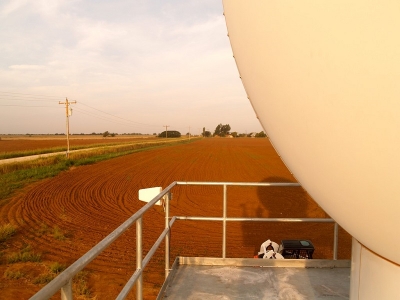The Impact of Soil Moisture on Rain
Published: 5 November 2018
Two University of Arizona researchers solve an old puzzle about the prevalence of rain and agricultural activity

A new paper, based on research funded by the National Aeronautics and Space Administration (NASA), strongly demonstrates “the substantial scientific value” of comprehensive data from the Southern Great Plains (SGP) atmospheric observatory, which is part of the Atmospheric Radiation Measurement (ARM) user facility funded by the U.S. Department of Energy (DOE).
So says the paper’s senior author, University of Arizona researcher Xubin Zeng. He and doctoral student Joshua Welty, the lead author, quantified the relationship between soil moisture and how precipitation amplifies over the central plains of the United States, a region crisscrossed by powerful summer storms.
They tapped SGP data from approximately 1,220 warm-season days from 2002 to 2011 to address the relationship of morning soil moisture to afternoon rainfall accumulations.
SGP, a long-time open-air laboratory for atmospheric science, spans 9,000 square miles of rural Oklahoma and Kansas. Its Central Facility is a heavily instrumented observatory set on 160 acres of cattle pasture and wheat fields—ideal for the work Welty and Zeng set out to do.
For decades, researchers have performed extensive land-atmosphere studies to unravel how soil moisture interacts with precipitation, “yet consensus remains elusive,” writes Zeng in the paper.
Does wet soil increase or decrease precipitation, or simply leave it unchanged? Welty and Zeng wanted to provide a definitive answer to a scientific controversy that has been debated for well over a century.
For years, farmers in the Midwest hewed to the idea that “the rain follows the plow.” That is, if farmland was plowed and irrigated, the moist soil would feed stronger rainfall.
Off and on, scientists have called that idea a myth. Welty and Zeng used their SGP data sets to find a middle ground, and to add nuances to an old question.
Their study appeared in the July 25, 2018, issue of Geophysical Research Letters, and is titled, “Does Soil Moisture Affect Warm Season Precipitation over the Southern Great Plains?”
The answer is “yes,” but in a nuanced way, since it depends on a given day’s atmospheric conditions.
Both dry and wet morning soils can signal heavier afternoon rain during warm summer months. But dry morning soils will do that only on days when regional moisture is limited—a so-called “low dynamic regime.” (Here, a “dynamic regime” is based on daily water vapor convergence in the atmosphere.)
Meanwhile, moist morning soils will signal afternoon rain only on days with a high dynamic regime—that is, when there is a strong regional convergence of atmospheric water vapor.
The researchers had to put their work into the context of what makes rain in the first place. It requires a source of moisture, which can come from a region’s vegetation, water bodies, and atmospheric humidity.
Rain also requires strong updrafts of air from Earth’s surface, which penetrate into cooler regions of the atmosphere—a dynamic that it turns out is enhanced by drier soils.
Dry soils are “like conveyor belts for warm air” relayed from the surface into the upper atmosphere, Zeng says in a university story on the research.
The work was novel enough to also draw coverage from an ABC-affiliated television station in Tucson, Arizona, which aired a prime-time story.
For now, the research reflects what happens in the wide, seasonally stormy plains of the American Midwest. However, the methods developed in the new paper could be applied to NASA satellite data and to other avenues of data that may someday inform large-scale earth system models.
Zeng offered as one example the Energy Exascale Earth System Model (E3SM) project, a computationally advanced climate-energy model being developed by DOE.
In the university story Welty says, “There is an exciting potential for global analysis.”
Keep up with the Atmospheric Observer
Updates on ARM news, events, and opportunities delivered to your inbox
ARM User Profile
ARM welcomes users from all institutions and nations. A free ARM user account is needed to access ARM data.


















